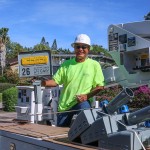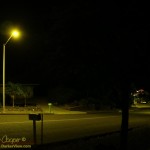It may be the day after Thansgiving, but that did not stop the electrical contractors installing new streetlamps in Waikoloa Village.

We are not sad to see the old low pressure sodium light go, it has been a nuisance. The poorly designed sodium lamp creating glare into our windows We had called to complain with the county, but nothing was ever done. The glare intruded on our bedroom window, a real issue, somewhat alleviated by the growth of our plumeria along the front blocking the light, a deliberate solution on my part.
The big question is whether the new LED light improves the astronomy situation from my driveway. The old sodium lamps along the street made it impossible to do visual observing, there was simply too much glare. The new lamps should darken the sky and create far less light directed at my driveway.
Even better, the lamps in question are C&W Energy Star Friendly® units with reduced blue emissions. Elimination of almost all of the blue light greatly reduces scatter in the atmosphere and is better for the observatories.

With the old light I was able to do astrophotography from the driveway using an LPR filter that blocked the 589nm of sodium light. The new lights will have a broader spectrum and be more difficult to block. On the other hand they send very little light upwards, possibly improving the situation. It will be interesting to see what the difference is. When the Moon is a few days further gone I will have to setup the camera and find out.
It may also be a good idea to check the old CloudCam images against new images as the replacement continues. It will be interesting to see if the emissions from the neighborhood are effectively reduced as seen from the top of the mountain.


Hi,
The lights look fantastic. There’s also an earlier post by you from 2012 showing similar (or the same lights) elsewhere in Hawaii. I once met an astronomer from Hawaii by the name of Richard Wainswright at a light pollution conference in New Zealand ( He’s an Australian actually). That was a few years ago and at the time the street lights being installed where in the 5000K range of CCT. I was at a light pollution conference in Canada a few months ago and the emphasis was on spectrum and CCT. Many people doing before/after comparisons would be looking at data from the Suomi satellite or the ISS. I can send you some URLs to look up if you want to pursue any of it further.
Cheers,
Mike Chapman
The earlier post is on the replacement of lights in Waimea. The new lights in Waikoloa are a different model, but also feature the same type of blue filters that remove the shorter wavelengths that are detrimental to wildlife and the observatories. If I recall properly Richard was instrumental in having the blue cutoff lights adopted for Hawaii.